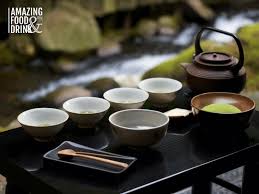BLOG
Japanese Tea A Timeless Tradition of Elegance and Flavour

Japanese tea is an important part of Japan’s culture and daily life. People in Japan have been drinking tea for hundreds of years. The most famous type is green tea which comes in many different flavours and styles. Japanese tea is not just a drink; it is a way to relax, enjoy nature and spend time with family and friends.
There are many types of Japanese tea like matcha sencha and hojicha. Each type has a different taste and way of making it. Some teas are strong and rich while others are light and refreshing. Many people love Japanese tea because it is healthy and full of antioxidants which help the body stay strong.
History and Origins of Japanese Tea
Japanese tea has a long and interesting history. Many years ago Buddhist monks brought tea seeds from China to Japan. These monks drank tea to stay awake while meditating. Over time tea became very popular in Japan. People started growing tea plants and making different types of tea.
During the 12th century a monk named Eisai introduced matcha tea to Japan. This was the beginning of the Japanese tea ceremony, a special way of making and drinking tea. As time passed tea became an important part of Japanese life. Even today many people in Japan enjoy drinking tea every day.
Types of Japanese Tea: From Matcha to Sencha
There are many kinds of Japanese tea and each one has its own special taste. Matcha is a bright green tea that is made from powdered tea leaves. It has a strong flavour and is used in the Japanese tea ceremony. Sencha is the most common type of tea in Japan. It is made by steaming and rolling tea leaves giving it a fresh and slightly sweet taste.
Other types of Japanese tea include gyokuro, a high-quality tea that is sweet and smooth and hojicha which is roasted and has a smoky flavour. There is also genmaicha, a mix of green tea and roasted rice giving it a nutty taste. Each type of tea is enjoyed in different ways and has its own health benefits.
The Japanese Tea Ceremony: A Ritual of Grace
The Japanese tea ceremony also called “chanoyu” is a beautiful and peaceful tradition. It is not just about drinking tea; it is about showing respect, harmony and peace. The tea ceremony follows a set of steps and every movement is done carefully and with meaning. People who take part in the ceremony wear special clothes and sit in a quiet tea room.
During the ceremony the host makes matcha tea in a careful and respectful way. The guests watch and enjoy the moment. The tea is served in a small bowl and each person takes a turn drinking from it. This ceremony teaches patience and mindfulness making it a special experience.
Health Benefits of Japanese Tea
Japanese tea is not only delicious but also very healthy. It is full of antioxidants which help the body fight diseases. Drinking tea every day can make the immune system stronger, help with digestion and even improve brain function. Many people believe that Japanese tea helps them feel fresh and full of energy.
Green tea, especially matcha, has catechins which help burn fat and keep the heart healthy. It is also known to reduce stress and help people relax. Because of these health benefits, Japanese tea is loved by people all over the world.
Brewing Techniques and Best Practices
Making Japanese tea the right way is very important. If the water is too hot the tea can taste bitter. If it is too cold the flavour will not be strong enough. The best way to make tea is to use warm water and let the tea leaves soak for the right amount of time.
For matcha the tea is whisked with a special bamboo whisk until it becomes smooth and foamy. For sencha the leaves are placed in a teapot and hot water is poured over them. The tea is then left to steep for a few minutes before being poured into cups. Knowing the best way to brew each type of tea makes the experience even more enjoyable.
Japanese Tea Culture in Modern Times
Even today Japanese tea is an important part of daily life in Japan. People drink tea at home, at work and in tea shops. In many Japanese homes there is a small teapot and tea cups ready for a relaxing break. Many restaurants also serve green tea with meals.
In modern Japan bubble tea and bottled green tea have also become popular. Young people enjoy these drinks because they are easy to carry and refreshing. Even though the world is changing, Japanese tea remains a special and loved tradition.
Famous Tea-Growing Regions of Japan
Japan has many places where tea is grown. The most famous regions are Shizuoka Uji and Kagoshima. Shizuoka is known for producing almost half of Japan’s tea. The tea from this region has a rich and smooth taste.
Uji near Kyoto is famous for matcha and gyokuro. The tea from Uji is high-quality and used in many tea ceremonies. Kagoshima in the south of Japan has a warm climate which helps grow strong and flavourful tea. These regions help keep the tradition of Japanese tea alive.
Conclusion
Japanese tea is more than just a drink; it is a way of life. It brings peace, health and tradition to people all over the world. Whether enjoyed in a ceremony, a café or at home, Japanese tea remains a symbol of Japan’s beauty and culture.
As people continue to learn about its benefits and flavours, Japanese tea will always be special. No matter where you are, a warm cup of tea can bring relaxation and happiness. The tradition of Japanese tea will surely continue for many generations to come.











